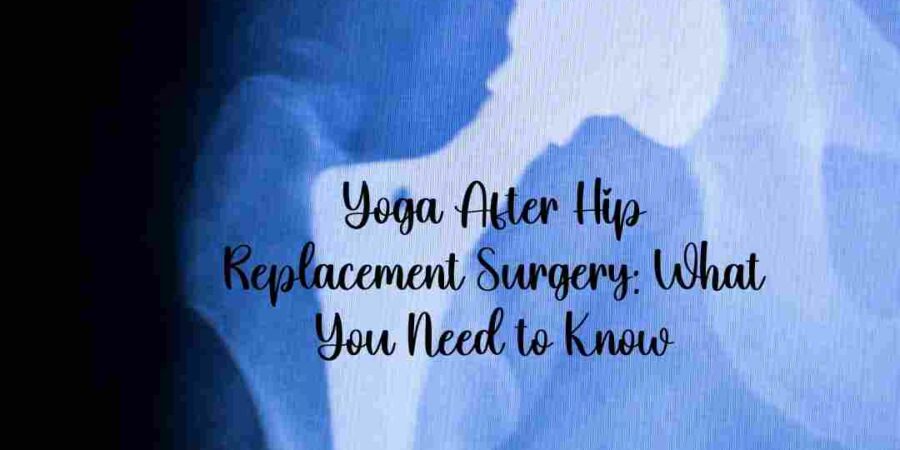We may earn money or products from the companies mentioned in this post.
After undergoing hip replacement surgery, many people are eager to get back to their normal activities, including their yoga practice. However, it is important to approach yoga after hip replacement surgery with caution and care.
As someone who has personally gone through this experience, I can attest to the importance of taking it slow and being mindful of your body’s limitations. First I do want to say DO NOT START ANYTHING without talking to your doctor.
Currently, I am on rest and have not been able to do any exercise including yoga. It’s time for me to listen to my body which I am doing.
One of the key things to keep in mind when practicing yoga after hip replacement surgery is to avoid any movements that involve excessive twisting or bending at the hip joint. This can put undue stress on the new joint and potentially lead to complications or further injury. Instead, focus on gentle movements that help to improve flexibility and strength in the surrounding muscles and joints.
What Causes the Need for Hip Replacement Surgery
Hip replacement surgery is a common procedure that is usually done to alleviate chronic hip pain. As someone who has undergone a hip replacement surgery, I can tell you that the decision to undergo the procedure is not an easy one. In my case, my hip pain was caused by years of wear and tear on my hip joint. Here are some common causes of hip pain that may lead to the need for hip replacement surgery:
- Osteoarthritis: This is the most common cause of hip pain that leads to hip replacement surgery. Osteoarthritis is a degenerative joint disease that can cause the cartilage in the hip joint to wear down over time.
- Rheumatoid arthritis: This is an autoimmune disease that causes inflammation in the joints. In some cases, rheumatoid arthritis can cause damage to the hip joint that may require hip replacement surgery.
- Trauma: A hip injury, such as a fracture, can cause damage to the hip joint that may require hip replacement surgery.
- Avascular necrosis: This is a condition that occurs when the blood supply to the hip joint is disrupted, causing the bone tissue to die. Avascular necrosis can lead to hip pain and may require hip replacement surgery.
- Childhood hip disease: Some childhood hip diseases, such as developmental dysplasia of the hip, can cause hip pain later in life that may require hip replacement surgery.
In my case, my hip pain was caused by osteoarthritis. Over time, the cartilage in my hip joint had worn down to the point where bone was rubbing against bone, causing pain and discomfort.
After exploring various treatment options, my doctor recommended hip replacement surgery as the best option to alleviate my pain and improve my quality of life.
Recovery Time Following Hip Replacement
After undergoing hip replacement surgery, the recovery time can vary from person to person. In general, it takes about 6 to 12 weeks to recover from the surgery. However, it can take up to a year to fully recover and return to normal activities.
During the first few weeks of recovery, I am using a walker. Next step will be a cane. I also have to avoid bending at the waist and crossing my legs. I was given exercises to do to help with my recovery, such as ankle pumps, heel slides, and leg lifts. These exercises helped to improve my range of motion and strength.
I was also instructed to avoid certain activities during my recovery period, such as high-impact sports, jogging, and lifting heavy objects. It was important for me to follow these instructions to prevent any complications and ensure a successful recovery.
As I progressed through my recovery, I was able to gradually increase my activity level and return to my normal routine. However, I still had to be cautious and avoid any activities that could put stress on my new hip joint.
Overall, the recovery time following hip replacement surgery can be a long process, but it is important to follow the instructions provided by your healthcare team to ensure a successful recovery.
Importance of Slowly Returning to Exercise After Hip Replacement Surgery
After undergoing hip replacement surgery, it is important to gradually return to physical activity. Rushing into exercise too quickly can lead to complications and slow down the recovery process. As someone who has undergone this surgery, I understand the importance of taking it slow and easing back into exercise.
When starting to exercise after hip replacement surgery, it is important to keep in mind that the body needs time to heal. It is recommended to start with low-impact exercises such as walking, swimming, or cycling. These exercises help to increase blood flow and promote healing without putting too much stress on the hip joint.
It is also important to listen to your body and not push yourself too hard. Overexertion can lead to pain and discomfort, which can slow down the recovery process. It is better to start with shorter sessions and gradually increase the duration and intensity of the exercise.
In addition to low-impact exercises, it is important to include stretching and flexibility exercises in your routine. These exercises help to improve range of motion and prevent stiffness in the hip joint.
Remember, returning to exercise after hip replacement surgery should be a gradual process. It is important to follow the guidance of your doctor and physical therapist, and to listen to your body. By taking it slow and gradually increasing the intensity of your exercise, you can promote healing and improve your overall health and well-being.
Best Exercise After Hip Replacement Surgery
After my hip replacement surgery, I am eager to get back to my yoga practice. However, I know at this moment I need to be cautious and choose exercises that would not put too much strain on my new hip. Here are some of the best exercises I found:
- Gentle stretches: Stretching is important to maintain flexibility and prevent stiffness after surgery. I found that gentle stretches such as the seated forward bend, seated spinal twist, and butterfly pose were helpful.
- Standing poses: Standing poses can help improve balance and stability. However, it’s important to avoid poses that require excessive bending or twisting of the hips. I found that the tree pose, warrior II, and triangle pose were good options.
- Chair yoga: Chair yoga can be a great way to ease back into a yoga practice after surgery. It allows you to practice yoga while seated, which reduces the amount of weight and pressure on your hip. I found that chair cat-cow, seated eagle pose, and seated spinal twist were effective.
- Breathing exercises: Deep breathing exercises can help reduce stress and promote relaxation. They also provide a gentle way to warm up before practicing other yoga poses. I found that the alternate nostril breathing technique and the ujjayi breath were helpful.
Remember to always listen to your body and never push yourself too hard. If you experience any pain or discomfort, stop the exercise immediately. It’s important to work with a qualified yoga instructor who has experience working with students who have had hip replacement surgery.
Permanent Restrictions Following Hip Surgery
After undergoing hip replacement surgery, there are some permanent restrictions that I need to keep in mind to ensure that my new hip joint remains healthy and functional. These restrictions are put in place to prevent any damage to the new joint and to reduce the risk of complications.
Firstly, I need to avoid any high-impact activities such as running, jumping, or any sport that involves sudden changes in direction. These activities put a lot of stress on the hip joint and can cause it to wear out faster or even dislocate.
Secondly, I need to avoid any activities that involve twisting or bending my hip joint beyond 90 degrees. This includes activities such as yoga poses like lotus pose, pigeon pose, or any pose that requires me to cross my legs. These movements can also cause the hip joint to dislocate or cause damage to the surrounding muscles and tissues.
Thirdly, I need to be careful when sitting on low chairs or toilet seats. I need to ensure that my hip joint is not flexed more than 90 degrees. To do this, I can use a raised toilet seat or a cushion to elevate the chair’s height.
Lastly, I need to avoid any activities that involve lifting heavy weights or carrying heavy objects. These activities put a lot of stress on the hip joint and can cause it to wear out faster.
Returning to Yoga Practice After Hip Surgery
After undergoing hip replacement surgery, it is important to take the necessary time to recover and heal properly before returning to your yoga practice. As someone who has gone through this experience myself, I understand the desire to get back to your regular routine as soon as possible. However, it is crucial to listen to your body and not push yourself too hard too soon.
Before returning to yoga, it is important to consult with your doctor or physical therapist to ensure that you are ready and cleared for physical activity. They may also provide you with specific exercises or modifications to incorporate into your yoga practice to help strengthen and protect your new hip.
When returning to yoga, it is important to start slowly and gradually increase your intensity and range of motion. It may be helpful to take a beginner or gentle yoga class to ease back into your practice. Additionally, be sure to communicate with your instructor about your recent surgery and any modifications or adjustments you may need during class.
During your yoga practice, it is important to listen to your body and not push yourself beyond your limits. Avoid any poses or movements that cause pain or discomfort in your hip. It may also be helpful to use props such as blocks or straps to assist with certain poses.
Overall, returning to yoga after hip replacement surgery can be a great way to improve flexibility, strength, and overall well-being. However, it is important to take the necessary precautions and listen to your body to ensure a safe and successful return to your practice.
Always Listen to Your Body
As someone who has undergone hip replacement surgery, I know firsthand how important it is to listen to your body during yoga practice. Even if you were an experienced yogi before your surgery, your body has undergone a significant change, and you need to approach your practice with caution.
One of the most important things to remember is to start slowly. Don’t push yourself too hard, and don’t try to do poses that you’re not ready for. It’s important to build up your strength and flexibility gradually, so that you don’t risk injuring yourself or damaging your new hip.
Another key factor is to be aware of your limitations. Your range of motion may be limited, and you may not be able to do certain poses that you used to do before your surgery. That’s okay. Accepting your limitations and working within them is an important part of any yoga practice.
It’s also crucial to pay attention to any pain or discomfort that you may experience during your practice. If something doesn’t feel right, stop immediately and assess what’s going on. Don’t push through the pain or try to ignore it. Pain is your body’s way of telling you that something is wrong, and it’s important to listen to that message.
Finally, don’t be afraid to modify poses to suit your needs. There are many ways to modify poses to make them more accessible, and your yoga instructor should be able to help you with this. Remember, yoga is about listening to your body and doing what feels right for you.
Always listen to your body during your yoga practice. Start slowly, be aware of your limitations, pay attention to any pain or discomfort, and don’t be afraid to modify poses. With time and patience, you can build a safe and enjoyable yoga practice that supports your healing and wellbeing.
Here are a few additional links you may find helpful:






